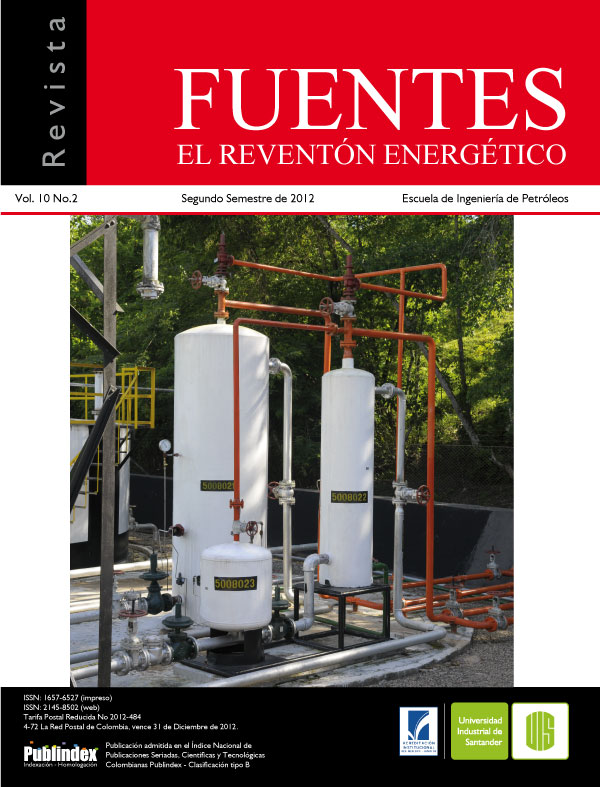Publicado 2012-11-28
Palabras clave
- Tubo de combustión,
- Combustión in situ,
- inyección de aire,
- reacciones de rompimiento
Cómo citar
Resumen
Durante y finalizada cada prueba de tubo de combustión, al desarmar y extraer el post-core de la prueba la producción de fluidos es analizada. Las emulsiones producidas son estudiadas con la adición de tolueno y centrifugación. Cada muestra de aceite es analizada para determinar su viscosidad y densidad. Además, se realiza un análisis del agua producida teniendo en cuenta la medición de pH, sólidos totales, el total de carbono, varios cationes y aniones tales como sulfatos, carbonatos, cloruros, magnesio, sodio y potasio.
El análisis más importante en las pruebas de tubos es el análisis de gases, este se hace para la determinación de parámetros estequiométricos, los cuales son utilizados para observar el desempeño del proceso y para el cálculo de los parámetros de diseño de un proceso de combustión in situ a escala de campo. Esto se hace con la ayuda de los resultados dados por cromatografía, donde se hallan las composiciones molares de los compuestos del gas que se produce. Con estos resultados se procede a calcular las variables más importantes para la evaluación del proceso. Con estas variables se pueden comparar pruebas hechas en laboratorio para observar si son o no exitosas o en que rango de temperatura se está operando.
Descargas
Referencias
2. BELGRAVE, Jhon D. M., MOORE GORDON and BENNION DOUGLAS W. The thermal behavior of vertically operated near-adiabatic in situ combustion tubes. J. Pet. Sci. Eng. 5 (1990) 51-65.
3. BURGER, Jacques G., SAHUQUET, Bernard C. Institute Francais Petroleo. SPE 00004144. 1973.
4. CHICUTA, A.M., TREVISAN, O.V., UNICAMP. Experimental study on in-situ combustion of brazilian heavy oil. SPE 122036.
5. DIETZ, Daniel N., Review of Thermal Recovery Methods. Member SPE-AIME, Delft University of Technology. Paper SPE 5558.
6. E.S., Juan, SANCHEZ, A., A. DEL MONTE Repsol YPF R.G. MOORE, S.A. MEHTA, M.G. URSENBACH University of Calgary. Laboratory Screening for air injection-based IOR in Two Water flooded Light Oil Reservoirs. JCPT 1998.
7. GREAVES, M., DUDLEYT, J W O and R W Field. Factorial Experiments in In-Situ Combustion. University of Bath. SPE 19463.
8. GUERRA, Jose Julian, “Diseño de un proceso de combustión segregacional In-Situ, para estructuras anticlinales con alto grado de buzamiento, incorporando tecnologías de pozos productores horizontales”, UIS, 2003, p. 327.
9. HOWARD, J. V., Status of thermal recovery. Paper SPE 1142-MS.
10. KUMAR, M., Chevron oil field research co. Simulation of Laboratory In-Situ Combustion data and effect of process variations.SPE 16027. 1995.
11. ONYEKONWU, M.O., U. OF PORT HARCOURT; PANDE, K., RAMEY, Jr., H.J., BRIGHAM, W.E., STANFORD U., Experimental and simulation studies of laboratory in-situ combustion recovery. Paper SPE 15090.
12. MAMORA, DAULAT DEBATARAJA, Ph.D. Kinetic of in situ combustion. Stanford University. 1993.
13. MARTIN, W.L, ALEXANDER, J.D &DEW, JN., Process variables of in situ combustion. Transaction AIME, 213.1958. p. 218-235.
14. MASAO, BENNION, Douglas W., DONNELLY, John K. and GORDON MOORE, Robert, Thermal cracking models for Athabasca oils and soil, SPE 7549, 197.
15. MOORE, R.G., URSENBACH, M., BENNION W.D. In situ combustion test on eye hill cummings reservoir. JCPT 90-06-03.
16. OKAZAWA, H.H. XU, N.E., R.G. MOORE, S.A. MEHTA, C.J. LAURESHEN, M.G. URSENBACH, D.G. MALLORY. In situ upgrading of heavy oil. University of Calgary. JCPT. 2000
17. PENBERTHY, Jr. W. L., Design and operating laboratory combustion tube. Texas College. Paper SPE 1290.
18. MOORE, R.G., LAURESHEN, C.J., M.G. URSENBACH, S.A. MEHTA, J.D.M. BELGRAVE, University of Calgary. Combustion/oxidation behavior of Athabasca oil sands bitumen. Paper SPE 35392.
19. RAMEY, Jr., HENRY.In-situ combustion. Stanford University. WPC.1971. 198920. REN S.R., HERIOT-WATT, U., M. GREAVES, and RATHBONE,R.R. Air injection LTO process: an IOR technique for light-oil reservoirs. SPE Journal. Paper SPE 57005, 2002.
21. RODRIGUEZ, Jose Ramon. Experimental and analytical study to model temperature profiles and stoichiometry in oxygen-enriched in-situ combustion. University of Calgary. May 2004.
22. SARATHI, Partha S., In-situ combustion handbook - principles and practices Final Report ‘November 1998.
23. THOMAS F.B., BENNION, D.W., MOORE, R.G. Using combustion tube data to tune a numerical simulation.PAPER PET-SOC. 83·34·44.
24. VENKATE V.N.. J.B. Otto IobIlR&D Oxygen fireflooding: Determination of maximum Water/oxygen ratio for normal wet combustion. SPE 21573.
25. YATTE, Fabian C., Combustión in situ. Grupo de investigación de Recobro Mejorado, UIS-ICP. 2009.
26. CHICHARRO, Manuel. Cromatografía, conceptos y aplicaciones. 2007.
27. URSERNBACH, Matthew G. An overview of laboratory in situ combustion behaviour of Athabasca oil sands. University of Calgary. 1992.
28. BENHAM A. L. The thermal recovery process- an analysis of laboratory combustion data. The Ohio Oil CO. 1958.
29. CRISTOFARI J. SPE, LM Castainer. Laboratory investigation of the effect of solvent injection on in situ combustion. Stanford U. SPE 99752.
